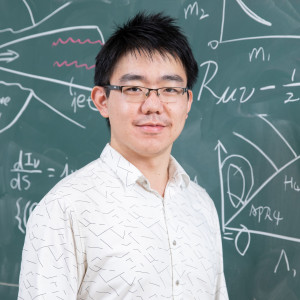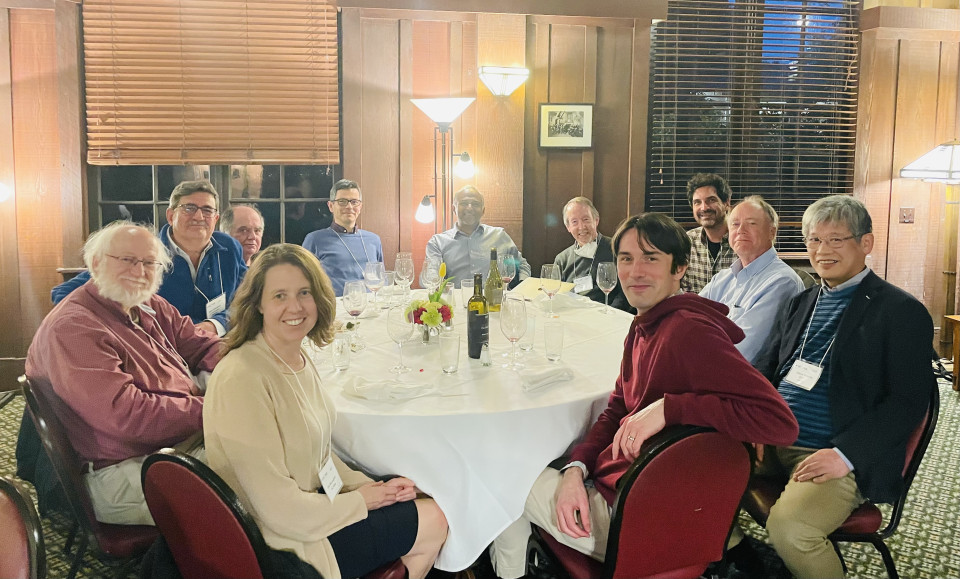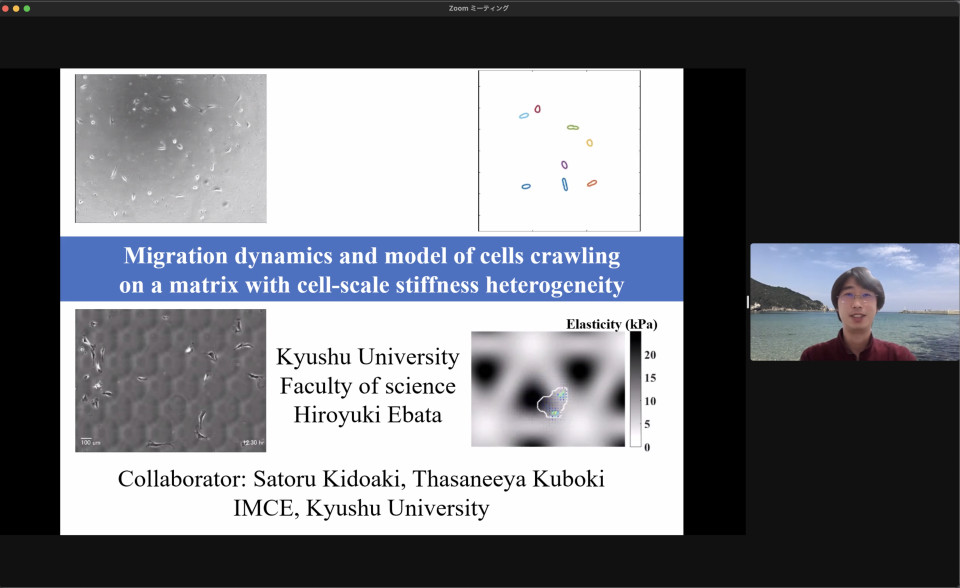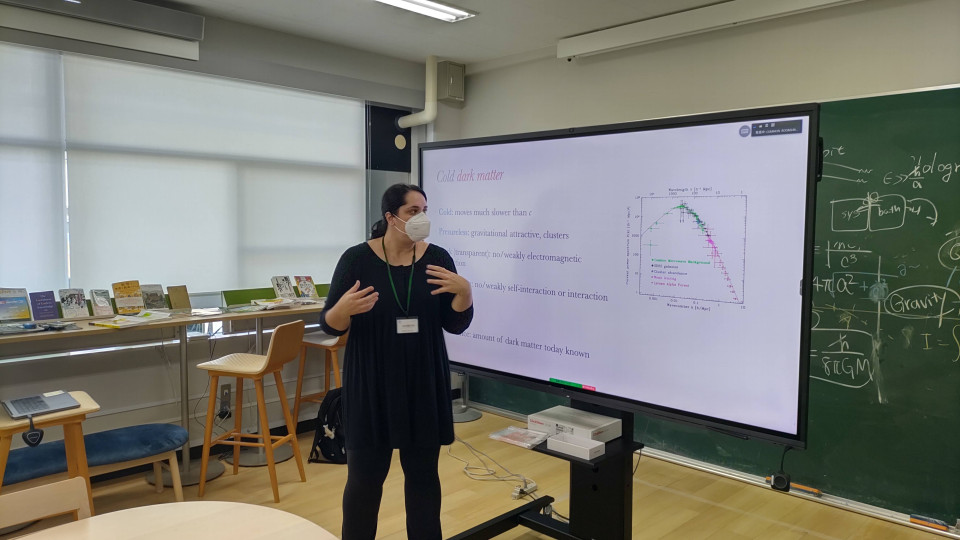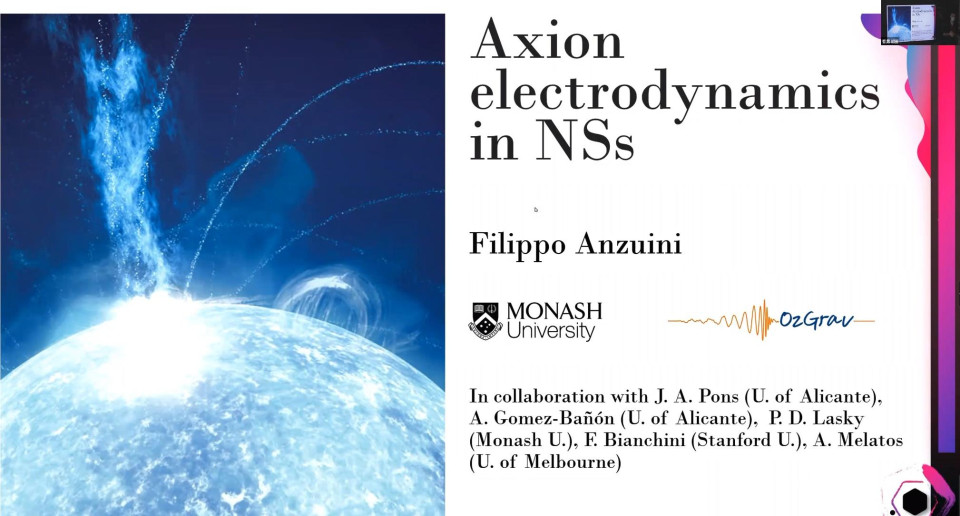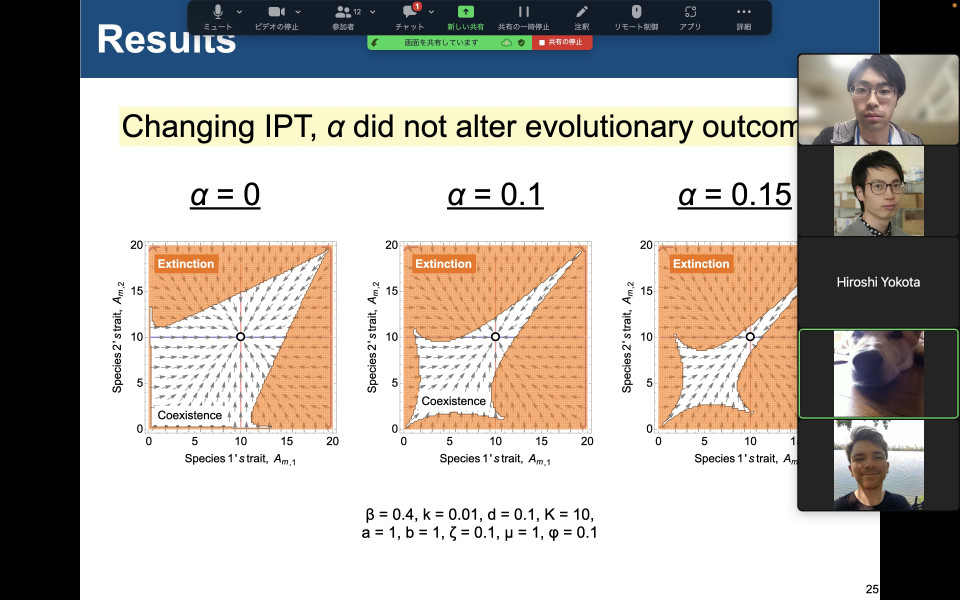Volume 222
Back to Newsletter List
Press Release
Probing Quark Matter with Gravitational Waves - Reading Traces of Ultra-Dense Matter from Gravitational Waves after Neutron Star Mergers
2022-10-27
An international research group including Yongjia Huang (Student Trainee, iTHEMS) and Shigehiro Nagataki (Deputy Program Director, iTHEMS) has performed numerical simulations based on general relativity for the merger of binary neutron stars and shown that the waveform of gravitational waves emitted after the merger provides detailed readings of the properties of ultra dense matter with a density of over 1 trillion kg per cm3. This research result is expected to contribute to the clarification of the internal structure of neutron stars and the properties of ultra-dense matter in gravitational wave astronomy.
For details, please see the related link.
Reference
- Yong-Jia Huang, Luca Baiotti, Toru Kojo, Kentaro Takami, Hajime Sotani, Hajime Togashi, Tetsuo Hatsuda, Shigehiro Nagataki, and Yi-Zhong Fan, Merger and Postmerger of Binary Neutron Stars with a Quark-Hadron Crossover Equation of State, Phys. Rev. Lett. 129, 181101 (2022), doi: 10.1103/PhysRevLett.129.181101
Hot Topic
Listening to Equation-of-State Changes
2022-10-28
The collaborative work on the quark matter and gravitational wave [1] led by our iTHEMS colleague, Yongjia Huang, together with Shigehiro Nagataki, Tetsuo Hatsuda, Kentaro Takami, Hajime Soltani and others, was featured in the Physics Magazine published by the American Physical Society with the title "Listening to Equation-of-State Changes" (see related links below). See how the general relativistic simulations of the postmerger gravitational waves from coalescing neutron stars could allow us to hear the phase transitions between exotic states of matter.
Reference
- Yong-Jia Huang, Luca Baiotti, Toru Kojo, Kentaro Takami, Hajime Sotani, Hajime Togashi, Tetsuo Hatsuda, Shigehiro Nagataki, and Yi-Zhong Fan, Merger and Postmerger of Binary Neutron Stars with a Quark-Hadron Crossover Equation of State, Phys. Rev. Lett. 129, 181101 (2022), doi: 10.1103/PhysRevLett.129.181101
Hot Topic
The RIKEN-Berkeley Center was featured in RIKEN Overseas Office Newsletter
2022-10-25
The RIKEN-Berkeley Center was featured in the Oct. 2022 issue of "News from RIKEN's Overseas Offices". The title of the article written by Adam Phillips in the RIKEN International Affairs Division is "What makes institutional international collaborations work?".
Enjoy the article!
Seminar Report
iTHEMS Biology Seminar by Dr. Hiroyuki Ebata on October 27, 2022
2022-10-27
On October 27th, Dr. Ebata talked about experiments and theoretical modeling of cell migration dynamics. In the introductory part, he explained the relation between fluctuations of the cell shape and migration dynamics, as well as the basics of durotaxis. After reviewing the experimental setups, he showed us the experimental results of cell migration dynamics on hydrogels with heterogeneous stiffness. He constructed models based on symmetry arguments and consistently explained the observed phenomena. We really enjoyed his clear talk with plenty of exciting movies on cell migration.
Reported by Kyosuke Adachi
Migration dynamics and model of cells crawling on a matrix with cell-scale stiffness heterogeneity
October 27 (Thu) 16:00 - 17:00, 2022
Seminar Report
iTHEMS Theoretical Physics Seminar by Prof. Elisa G.M. Ferreira on October 11, 2022
2022-10-24
In her talk, Dr. Elisa Ferreira exploited some of the intriguing models of dark matter (DM), one of the biggest mysteries in cosmology. While there are many different models to explain the nature of this elusive component, she presented a class of dark matter models: ultra-light dark matter (ULDM) or ultra-light axions (ULA). She explained that one of the most interesting features of this class of DM models is that it might condense in the interior of the halos of galaxies forming a Bose-Einstein condensate or superfluid. This interesting quantum phenomena on macroscopic scales, and the wave nature of ULDM leads to different and interesting astrophysical consequences that can be probed on small scales. She first reviewed the fuzzy dark matter model, one of the most well studied ULA models, and then introduced the DM superfluid model. Upon condensation in the interior of galaxies, DM dynamics in this model can represent that of so-called modified Newtonian dynamics on galactic scales. Dr. Ferreira showed the theoretical description of this model and its interesting phenomenology, especially on small scales.
Reported by Ryo Namba
Ultra-Light Axion Dark Matter: Bose-Einstein condensates and superfluids in the sky
October 11 (Tue) 13:30 - 15:00, 2022
Seminar Report
iTHEMS Seminar by Dr. Filippo Anzuini on September 27, 2022
2022-10-24
The main focus of Dr. Filippo Anzuini's talk was on axions, which are pseudo-Goldstone bosons that provide a solution to the strong CP problem, and are prominent candidates for dark matter. In neutron stars, it has been shown recently that the potential of the QCD axion acquires finite density corrections that shift the axion field expectation value, which can be large compared to the vanishing expectation value in vacuum. Such a shift leaves an imprint on typical neutron star observables such as the redshifted thermal luminosity, which can be used to constrain the axion parameter space. In his talk, Dr. Anzuini discussed the coupling of axions with photons, which modifies Maxwell’s equations and alters the neutron star magnetic field. By performing state-of-the-art magneto-thermal simulations, he performed his calculations of the axion-induced perturbations to the neutron star’ magnetic field, and showed that they grow on relatively short time-scales. Intense electric currents then lead to enhanced ohmic dissipation, increasing the stars’ observable thermal luminosity. The activation of such mechanisms depends on the axion decay constant and the axion mass. His results indeed opened a new astrophysical avenue to constrain axions, extending significantly the parameter range that can be probed with direct axion searches.
Reported by Ryo Namba
Axion electrodynamics in neutron stars
September 27 (Tue) 14:00 - 15:00, 2022
Seminar Report
iTHEMS Theoretical Physics Seminar by Dr. Yuko Urakawa on July 27, 2022
2022-10-24
In her talk, Prof. Yuko Urakawa discussed the generalized deltaN formalism of cosmological perturbations, which dramatically facilitates a computation of the primordial density perturbation and the primordial gravitational waves. In particular, she addressed a violation of the cosmological principle, namely a violation of the global isotropy in the Universe. A major implication of her study is that measuring the PGWs provides a powerful tool to explore a violation of the global isotropy. Such effects can potentially be searchable by the future space-based CMB polarization mission LiteBIRD.
Reported by Ryo Namba
Test of the Cosmological principle by observing the primordial gravitational waves
July 27 (Wed) 13:30 - 15:00, 2022
Seminar Report
iTHEMS Biology Seminar by Mr. Keiichi Morita on October 20, 2022
2022-10-21
I talked about my research progress about a mathematical model on how interspecific pollen transfer can affect coexistence and evolution of sex allocation.
First, analytical results without evolution showed that interspecific pollen transfer had negative impacts on coexistence by preventing fertilization in the other species. Also, asymmetry of sex allocation between species promoted extinction of either species.
Second, analytical results with evolution of sex allocation revealed that sex allocation always evolved into one regardless of strength of interspecific pollen transfer.
Although my model is very tough to understand, thank you for your listening and giving me comments!
Reported by Keiichi Morita
How can interspecific pollen transfer affect coexistence and evolution of sex ratio of two closely related plant species?
October 20 (Thu) 16:00 - 17:00, 2022
Upcoming Events
Seminar
iTHEMS Math Seminar
Measuring diversity: species similarity
October 28 (Fri) 16:00 - 17:00, 2022
Tom Leinster (Professor, University of Edinburgh, UK)
Traditional measures of the diversity of an ecological community depend only on how abundant the species are, not the similarities or differences between them. To better reflect biological reality, species similarity should be incorporated. Mathematically, this corresponds to moving from probability distributions on sets to probability distributions on metric spaces. I will explain how to do this and how it can change ecological judgements. Finally, I will describe a surprising theorem on maximum diversity (joint with Meckes and Roff), which reveals close connections between maximum diversity and invariants of geometric measure.
Venue: via Zoom
Event Official Language: English
Seminar
DMWG Seminar
Gamma-ray emission from the Sagittarius Dwarf Spheroidal galaxy due to millisecond pulsars
October 28 (Fri) 17:00 - 18:00, 2022
Oscar Macias (Faculty of Science, University of Amsterdam, Netherlands)
The Fermi Bubbles are giant, gamma-ray emitting lobes emanating from the nucleus of the Milky Way discovered in ~1-100 GeV data collected by the Fermi Gamma-Ray Space Telescope. Previous work has revealed substructure within the Fermi Bubbles that has been interpreted as a signature of collimated outflows from the Galaxy's super-massive black hole. In this talk, I will show that much of the gamma-ray emission associated to the brightest region of substructure -- the so-called cocoon -- is likely due to the Sagittarius dwarf spheroidal (Sgr dSph) galaxy. This large Milky Way satellite is viewed through the Fermi Bubbles from the position of the Solar System. As a tidally and ram-pressure stripped remnant, the Sgr dSph has no on-going star formation, but I will demonstrate that the dwarf's millisecond pulsar (MSP) population can plausibly supply the observed gamma-ray signal. This finding plausibly suggests that MSPs produce significant gamma-ray emission amongst old stellar populations, potentially confounding indirect dark matter searches in regions such as the Galactic Centre, the Andromeda galaxy, and other massive Milky Way dwarf spheroidals.
Venue: via Zoom
Event Official Language: English
Seminar
iTHEMS Theoretical Physics Seminar
Tensor renormalization group approach to quantum fields on a lattice
November 8 (Tue) 13:30 - 15:00, 2022
Shinichiro Akiyama (Specially Appointed Assistant Professor, Quantum Software Project, The University of Tokyo)
Tensor renormalization group (TRG) approach is a variant of the real-space renormalization group to evaluate the path integral defined on the thermodynamic lattice, without resorting to any probabilistic interpretation for the given Boltzmann weight. Moreover, since the TRG can directly deal with the Grassmann variables, this approach can be formulated in the same manner for the systems with bosons, fermions, or both. These advantages of the TRG approach have been confirmed by the earlier studies of various lattice theories, which suggest that the TRG enables us to investigate the parameter regimes where it is difficult to access with the standard stochastic numerical methods, such as the Monte Carlo simulation. In this talk, explaining our recent applications of the TRG approach to several lattice models, we demonstrate the efficiency of the TRG as a tool to investigate lattice theories particularly in higher dimensions and future perspective.
Venue: Hybrid Format (Common Room 246-248 and Zoom)
Event Official Language: English
Lecture
An Introduction to Quantum Measurement Theory for Physicists
November 10 (Thu) - 12 (Sat) 2022
Masahiro Hotta (Assistant Professor, Department of Physics, Graduate School of Science, Tohoku University)
In this lecture, basic concepts in quantum measurement theory are introduced, including measurement operators and POVM's. The related topics are also picked up.
Lecture 1: Nov. 10, 10:30 - 12:00
Lecture 2: Nov. 10, 13:30 - 15:00
Lecture 3: Nov. 10, 15:30 - 17:00
Lecture 4: Nov. 11, 10:30 - 12:00
Lecture 5: Nov. 11, 13:30 - 15:00
Lecture 6: Nov. 12, 10:30 - 12:00
Venue: #345-347, 3F, Main Research Building, RIKEN Wako Campus / via Zoom
Event Official Language: English
Paper of the Week
Week 5, October 2022
2022-10-27
Title: Bump of sound velocity in dense 2-color QCD
Author: Etsuko Itou, Kei Iida
arXiv: http://arxiv.org/abs/2210.14385v1
Title: High-energy properties of the graviton scattering in quadratic gravity
Author: Yugo Abe, Takeo Inami, Keisuke Izumi
arXiv: http://arxiv.org/abs/2210.13666v1
Title: Double and Quadruple Flat Bands tuned by Alternative magnetic Fluxes in Twisted Bilayer Graphene
Author: Congcong Le, Qiang Zhang, Cui Fan, Xianxin Wu, Ching-Kai Chiu
arXiv: http://arxiv.org/abs/2210.13976v1
Title: Slowly Decaying Ringdown of a Rapidly Spinning Black Hole: Probing the No-Hair Theorem by Small Mass-Ratio Mergers with LISA
Author: Naritaka Oshita, Daichi Tsuna
arXiv: http://arxiv.org/abs/2210.14049v1
Title: Neutron star mass formula with nuclear saturation parameters for asymmetric nuclear matter
Author: Hajime Sotani, Shinsuke Ota
arXiv: http://arxiv.org/abs/2210.11651v1
If you would like to cancel your subscription or change your email address,
please let us know via our contact form.
Copyright © iTHEMS, RIKEN. All rights reserved.


